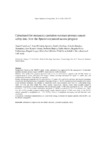Mostrar o rexistro simple do ítem
Cabazitaxel for metastatic castration-resistant prostate cancer: safety data from the Spanish expanded access program
| dc.contributor.author | Castellano, Daniel | |
| dc.contributor.author | Antón-Aparicio, Luis M. | |
| dc.contributor.author | Esteban, Emilio | |
| dc.contributor.author | Sánchez-Hernández, Alfredo | |
| dc.contributor.author | Germá, José Ramón | |
| dc.contributor.author | Batista, Norberto | |
| dc.contributor.author | Maroto, Pablo | |
| dc.contributor.author | Pérez-Valderrama, Begoña | |
| dc.contributor.author | Luque, Raquel | |
| dc.contributor.author | Méndez-Vidal, María José | |
| dc.date.accessioned | 2019-01-21T13:01:23Z | |
| dc.date.available | 2019-01-21T13:01:23Z | |
| dc.date.issued | 2014-07-07 | |
| dc.identifier.citation | Castellano D, Antón Aparicio LM, Sánchez Hernández A, et al. Cabazitaxel for metastatic castration-resistant prostate cancer: safety data from the Spanish expanded access program. Expert Opin Drug Saf. 2014; 13(9): 1165-1173 | es_ES |
| dc.identifier.issn | 1474-0338 | |
| dc.identifier.uri | http://hdl.handle.net/2183/21608 | |
| dc.description.abstract | [Abstract] BACKGROUND: Based on the TROPIC study results, cabazitaxel was approved for the management of metastatic castration-resistant prostate cancer (mCRPC) progressing on or after docetaxel. METHODS: This multi-centre program provided early access to cabazitaxel to patients with mCRPC before its commercialization. Safety data from 153 Spanish patients receiving cabazitaxel 25 mg/m(2) i.v. Q3W, plus oral prednisone/prednisolone 10 mg daily, are reported. RESULTS: Median age of patients was 70 years (26.8% ≥ 75 years), 94.1 and 26.8% had bone and visceral metastasis, respectively. Most had an Eastern Cooperative Oncology Group ≤ 1 (88.9%) and had received a median of 8.0 cycles of last docetaxel treatment. The median of cabazitaxel cycles and cumulative dose were 6.0 (Interquartile range [IQR]: 4.0; 8.0) and 148.9 (IQR: 98.2; 201.4) mg/m(2), respectively. Adverse events (AEs) possibly related to cabazitaxel occurred in 143 (93.5%) patients. The most frequent grade ≥ 3 AEs were neutropenia (n = 25, 16.3%) and asthenia (n = 17, 11.1%). Febrile neutropenia and grade ≥ 3 diarrhea occurred in 5.2% of the patients each. There were five (3.3%) possibly treatment-related deaths, mainly infection-related. G-CSFs were used in 114 (74.5%) patients, generally as prophylaxis (n = 107; 69.9%). Grade ≥ 3 peripheral neuropathy and nail disorders were uncommon. CONCLUSIONS: Cabazitaxel administration, in a real-world setting, is tolerated by Spanish patients with mCRPC, and the AEs are manageable. | es_ES |
| dc.language.iso | eng | es_ES |
| dc.publisher | Taylor & Francis | es_ES |
| dc.relation.uri | https://doi.org/10.1517/14740338.2014.939583 | es_ES |
| dc.rights | Thsi is an accepted manuscript of an article published by Taylor & Francis in Expert Opinion on Drug Safety, avaliable online at Taylor & Francis Online. | es_ES |
| dc.subject | Cabazitaxel | es_ES |
| dc.subject | Compassionate use studies | es_ES |
| dc.subject | Docetaxel | es_ES |
| dc.subject | Prostatic neoplasms | es_ES |
| dc.subject | Safety | es_ES |
| dc.title | Cabazitaxel for metastatic castration-resistant prostate cancer: safety data from the Spanish expanded access program | es_ES |
| dc.type | info:eu-repo/semantics/article | es_ES |
| dc.rights.access | info:eu-repo/semantics/openAccess | es_ES |
| UDC.journalTitle | Expert Opinion on Drug Safety | es_ES |
| UDC.volume | 13 | es_ES |
| UDC.issue | 9 | es_ES |
| UDC.startPage | 1165 | es_ES |
| UDC.endPage | 1173 | es_ES |
Ficheiros no ítem
Este ítem aparece na(s) seguinte(s) colección(s)
-
GI-FENM - Artigos [119]






